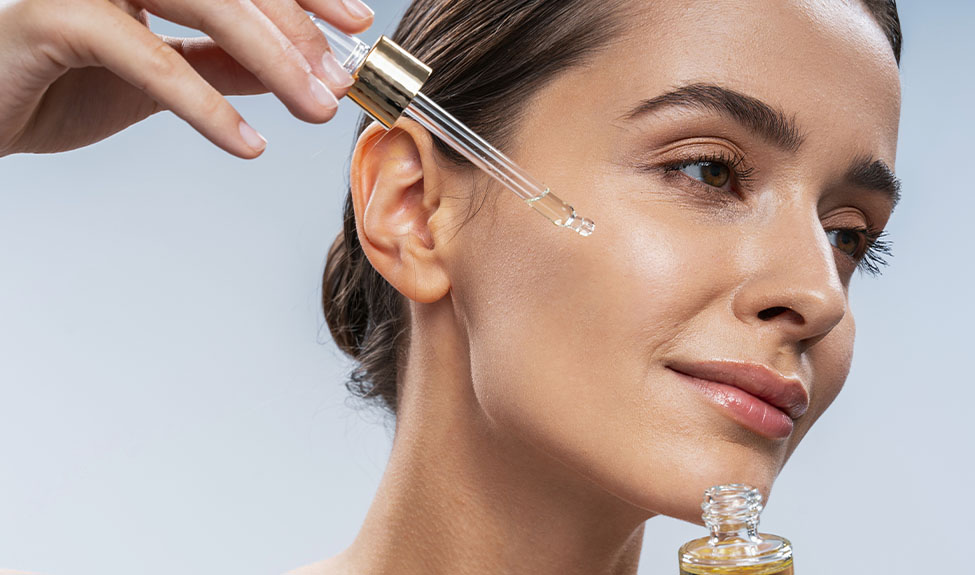While it’s your job to administer facial treatments as a skincare professional, you understand that one focused treatment isn’t enough to solve all of your clients’ skincare woes. At-home maintenance supplemented with monthly facials is the key to healthy, glowing skin.
Some clients who walk into your spa are overwhelmed simply by the idea of cleansing and moisturizing twice a day. For these clients, it’s best to keep product recommendations light and easy. For those clients who have been putting time and effort into skincare for a while, however, it might be time to suggest an upgrade. Facial serums make an excellent addition to an established skincare routine and could be just what your clients need to really start seeing results.
The word serum can be scary and confusing for some clients, so it’s your job to explain what a serum is, what it can do for the client’s skin, and how to use it.
Here’s what your clients need to know…
Understanding the Benefits of Facial Serums
The best way to describe a facial serum to your clients is as a lightweight moisturizer that contains a high concentration of active ingredients. These active ingredients vary according to what benefit the serum is intended to provide. For example, hydrating serums tend to feature hyaluronic acid while brightening serums are loaded up with vitamin C.
Because serums are lighter in weight than your typical moisturizer, they’re perfect for layering. Some clients might prefer not to use them in a daytime skincare regimen, but they’re easy to include in a nighttime routine. A little bit goes a long way, so even though serums sometimes require a significant upfront investment, they’ll last for weeks or months on end.
Here are some of the other benefits of serums you might pass on to your clients:
- They absorb quickly into the skin for faster results and immediate benefit.
- The lighter preparation is often gentler on oily and acne-prone skin.
- Many serums contain anti-aging ingredients like retinol that reduce the appearance of fine lines and wrinkles.
- Serums can be infused with antioxidants to protect the skin from free radical damage.
- They don’t feel heavy or greasy on your skin like some products.
- Serums can be made with higher concentrations of active ingredients than other products.
Understanding the benefits of facial serums is one thing but incorporating them into a daily skincare routine is another. It’s your job as a skincare professional to know which clients will benefit from a serum and, more importantly, which ones will actually use it.
Which Clients Can Benefit from Serums?
View this post on Instagram
In short, every client can benefit from including a serum in their daily routine; it’s just a matter of choosing the right one. Selecting a serum comes down to the client’s skin type and their primary (or most pressing) skin concern.
Serums generally fall into the following categories:
- Anti-aging
- Brightening
- Hydrating
- Anti-acne
- Soothing
- Reparative
- Protective
Many serums are designed to correct current skin concerns. Anti-aging serums, for example, typically aim to lift and firm the skin, reducing the appearance of fine lines and wrinkles. Brightening serums help correct hyperpigmentation and hydrating serums impart moisture. Anti-acne serums may address issues with excessive oil production or fighting active breakouts. Some serums are designed to help soothe irritated or sensitive skin and others help improve skin texture or protect against free radicals and environmental aggressors.
When introducing your client to serums, it’s important to recognize the difference between day serums and night serums. Certain active ingredients like vitamin C can boost the protective effects of sunscreen during the day while retinol can increase the skin’s photosensitivity. Hydrating serums can generally be used day or night, so these are a great option when recommending serum to a client for the first time.
If you’re working with a new client, you may not have enough information or experience with the client’s skin to make a serum recommendation. It never hurts to be cautious when it comes to skincare, so you might suggest a second treatment before taking the client’s skincare routine to the next level. For regular clients, adding a serum might be a quick and easy upgrade to the client’s daily regimen.
Tips for Making Recommendations
Product recommendations shouldn’t be pushy, but they are an integral part of any professional skincare treatment. If your clients want to maintain their results at home and continue improving the health and appearance of their skin over time, they need to take care of it between appointments.
Recommending a serum can be as simple as identifying your client’s primary skin concern. Serums are perfect for intensive treatment to boost hydration, brighten dark spots, or reduce the visible signs of aging. It never hurts to ask your client about their at-home skincare goals but, if they don’t have any input, you can always go with something that supports the work you did during the treatment.
For clients with mature skin or aging concerns, a youth restorative serum like Cellular Code is a great choice. This serum enhances cellular longevity and helps optimize skin functions to smooth wrinkles, even the complexion, and firm the skin. Clients with mature skin may also appreciate the firming benefits of Advanced Optimizer Serum. This anti-aging formula lifts and tightens the skin through the regenerative powers of hibiscus and soy peptides as well as marine collagen.
If your client has dry skin or no specific skin concerns, you can’t go wrong with a hydrating serum like Hydra No. 1. Infused with micro-molecular hyaluronic acid and aloe vera, this formula restores hydration and comforts the skin, leaving it soft and supremely radiant.
When introducing a facial serum into a client’s daily skincare routine, remind the client to start slow. Any new product should be patch tested and used no more than twice a week at first to make sure the skin doesn’t have any negative reactions.

